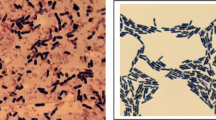Bacillus thuringiensis is found naturally on the phylloplane. In this study 35 samples from 13 species of the genus Piper (Piperaceae) were collected from three altitudinal levels located between 1800 and 2900 m above sea level in the Colombian Andean forest of Central Cordillera. Two hundred and fifty-six isolates of B. thuringiensis were obtained from 74% of the samples studied. B. thuringiensis index (number of isolates of B. thuringiensis/number of isolates of sporulated bacilli) was 0.2. The isolates were characterized by crystal morphology, the presence of cry genes by PCR, and toxicity against insects. Fifty-five percent of the isolates found presented bipyramidal-crystal morphology, and 42% had round-crystal morphology. Seventy percent of the isolates amplified cry1 [cry one] genes (generally toxic to lepidopterans); 41.4% amplified cry4 and/or cry11 [cry eleven] genes (generally toxic to dipterans), and none of the isolates amplified cry3 genes (generally toxic to coleopterans). The most abundant genotype of cry genes (54.7% of the total) was cry1Aa, cry1Ab, cry1Ac, cry1Ad, and cry1B. From the total isolates found, 7.8% presented both cry1 and cry11 genes, and five isolates (2.0%) harbored cry1, cry4, and cry11 genes; all these isolates were toxic to Culex quinquefasciatus (Diptera) but not to Spodoptera frugiperda (Lepidoptera). To our knowledge, these genotypes have not been previously reported. Overall, almost 60% of the isolates were toxic to S. frugiperda, and a little more than 40% of the isolates were toxic to C. quinquefasciatus. The populations of viable vegetative cells and spores per unit area were estimated and studied statistically. No significant differences in the number of B. thuringiensis isolates per cm2 of leaf among the three altitudinal levels were found, nor were they found among the different Piper species evaluated. This study increases the knowledge of the ecology of B. thuringiensis.
Similar content being viewed by others
Author information
Authors and Affiliations
Rights and permissions
About this article
Cite this article
Maduell, P., Callejas, R., Cabrera, K. et al. Distribution and Characterization of Bacillus thuringiensis on the Phylloplane of Species of Piper (Piperaceae) in Three Altitudinal Levels . Microb Ecol 44, 144–153 (2002). https://doi.org/10.1007/s00248-002-1018-z
Received:
Accepted:
Issue Date:
DOI: https://doi.org/10.1007/s00248-002-1018-z




